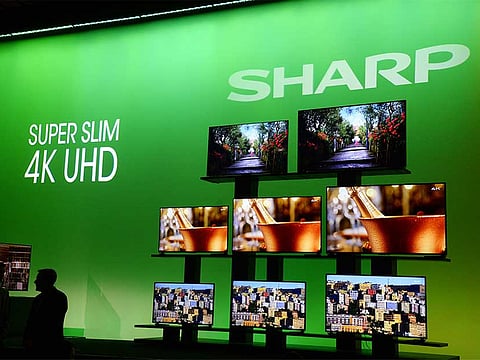Sharp sparks new interest in next generation TV technology
Is working with Japanese broadcaster to launch 8K TV

Dubai: Sharp is breaking down boundaries by changing the way people use technology as the company tries to spark new interest in the next generation of display know-how in bid to differentiate from the crowd.
When 4K TV technology, also known as ultra high-definition (UHD) with a resolution of 3840 x 2160 pixels, is slowly gaining traction, the Japanese giant is already working on 8K LCD display technology.
The standard Full HD TV has a resolution of 1920 x 1080 pixels. The 8K TV has a resolution of 7,680 x 4,320 pixels, which is 16 times that of standard HD TV and four times that of 4K TV.
LG and Samsung both demonstrated 98-inch 8K prototype TVs at IFA in Berlin last year.
Fumio Yamaguchi, managing director at Sharp Middle East and Africa, told Gulf News that the Japanese government has redrawn a road map for 8K and Sharp is introducing new cutting-edge technologies, especially in the LCD space.
“We are working with Japan Broadcasting Corp (Nippon Hoso Kyokai or NHK) for the past many years. As Japan is hosting the 2020 Summer Olympics in Tokyo, NHK will be launching 8K contents in 2018,” he said.
NHK plans to start testing 8K broadcasting in 2016 during the Rio de Janeiro Olympics.
He said that Sharp will be the first company to launch a 8K TV with ‘BT. 2020’ standard set by the International Telecommunications Union last year.
Normally, conventional values of LCD technologies are high resolution, high brightness, wider viewing angle and power consumption.
“We plan to add new more value to the consumers like design, tougher environment tolerance and more user-friendly interface by shifting away from the normal conventional values,” he said.
In a bid to truly take advantage of 4K and 8K TVs, content made in such resolutions is needed.
So far, only a few like Netflix, YouTube and Amazon Prime Instant has launched contents in 4K, and 8K looks still years away.
But with Sony already having 8K production cameras available in the market and others to follow soon, 8K TVs can’t be far behind.
“We expect 4K contents to be available in the next two to three years,” Yamaguchi said.
By 2018, six broadcasters are expected to be broadcasting dedicated 4K channels.
Even though the TV industry is focusing on 4K technology now, Sharp has launched a new technology called Quattron Pro by adding yellow to the conventional primary colours of red, green and blue.
Yamaguchi said that by adding yellow in a pixel, the colour range expands. Yellow, cyan (blue), and gold are beautifully reproduced.
He said that it can match a 4K TV resolution as Quattron Pro generates four times more luminance peaks per pixel than Full HD. Therefore, it results in 3840 x 2160 luminance peaks in total, which is equivalent to the number of luminance peaks for 4K TV.
Every technology has pros and cons, he said and added that Sharp has 4K TV technology but it is available only in Japan.
“We want to be in every aspect of technology to be offered to the consumers and it is up to them [consumers] to decide which technology they need,” he said.
Quattron Pro TVs with 67, 70 and 80 inches are available in the local market.
Sharp, at the moment, has no plan to go for less than 67-inch Quattron Pro TVs.
“The benefit of high-resolution pictures can be felt only on bigger screens,” he said.
Moreover, the Japanese company in collaboration with Qualcomm unit Pixtronix will be launching a seven-inch Mems-IGZO display tablet in 2015.
IGZO (indium, gallium, zinc, oxygen) is the proprietary technology of Sharp and micro-electro-mechanical system (Mems) is the proprietary technology of Pixtronix.
Sharp has already launched smartphones in Japan with IGZO screens which has minimum bezel.
“The Mems shutter display technology gives very high brightness under bright sunshine. It will be launched in Japan in the first half of next year with seven-inch tablet,” Yamaguchi said.
Normally, tablets and smartphones use LCD displays but by using the thin Mems-IGZO display, the images are crisper and sharper with high pixel per inch density.
Sign up for the Daily Briefing
Get the latest news and updates straight to your inbox


